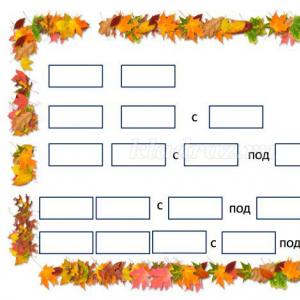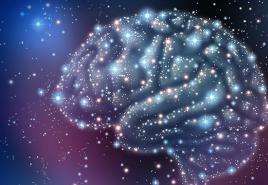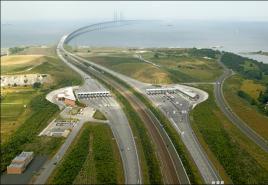H2o decompose into ions. Do not sign for ions
oxides incl. H 2 O, precipitates (solubility table), weakly dissociating compounds: H 2 S; HNO 2, H 2 SO 3 → SO 2 + H 2 O, H 2 CO 3 → CO 2 + H 2 O, NH 4 OH → NH 3 + H 2 O; CH3COOH; HMnO 4 H 2 SiO 3 , H 3 PO 4
The following have a constant oxidation state:
Group I main subgroup +1, group II main subgroup +2, H +, O -2, OH -, Al 3+, Zn 2+.
Redox reactions(ORD) are reactions in which elements change their oxidation state (CO) by transferring electrons.
Algorithm for solving redox reactions
We put down the oxidation state (CO) of each element in the reaction.
Find elements that change their oxidation state.
We select ions or molecules that contain elements with a changed degree of oxidation.
We sign the oxidizing agent, reducing agent.

Sour environment: add nH 2 O, where the lack of O → 2nH +
Alkaline environment: add nH 2 O, where the excess O → 2nOH -
We equalize each half-reaction (the left side of the half-reaction = the right one), we write down the number of given and received electrons.
We equalize the number of received and given electrons, set the coefficients in front of the half-reactions.
We sign the oxidation process and the recovery process.
We write the total ionic equation taking into account the coefficients.
We transfer the coefficients from the ionic to the molecular equation, give similar ones (left side of the reaction = right)
|
Corrosion: oxidation (destruction) of metal under the action of the environment The anode is to the left in the series of metal voltages. The cathode is to the right. Anode coating (to the left in the series of voltages; it is better, because the top layer is destroyed). Cathode coating (to the right in the voltage series). |
|
|
humid environment, alkaline environment |
/A/: Me 0 – nē→Me n + oxidation process /K/: 1/2O 2 +H 2 O+2ē→2OH - oxidation process |
|
acidic environment |
/K/: 2H + +2ē→H 2 - oxidation process |
|
On the example of Fe–Cu corrosion A (Fe): Fe 0 -2e → Fe 2+ K (Cu): 1 / 2O 2 + H 2 O + 2e → 2OH - - humid environment, alkaline environment K(Cu): 2H + +2e→H 2 - acidic Products: in an alkaline environment 4Fe (OH) 2 + O 2 + 2H 2 O \u003d 4 Fe (OH) 3, Fe(OH) 3 → Fe 2 O 3 + H 2 O. (rust) Products in an acidic environment: FeSO 4 |
|

http://ru.wikipedia.org/wiki/%DD%EB%E5%EA%F2%F0%EE%EB%E8%E7
According to Faraday's law: m \u003d EIt / 96 500, Q \u003d It, C (electricity consumed)
where m is the mass of the substance oxidized or reduced at the electrode; E is the equivalent mass of the substance; I - current strength, A; t is the duration of electrolysis, s. Ve H 2 \u003d 11.2 l, Ve O 2 \u003d 5.6 l

To memorize cathodic and anode processes in electrochemistry, there is the following mnemonic rule:
Anions are oxidized at the anode.
At the cathode, cations are reduced.
In the first line, all words begin with a vowel, in the second - with a consonant.
Or easier:
CAThode - CATions (ions at the cathode)
ANod - ANions (ions at the anode)
Ion exchange reactions are reactions in aqueous solutions between electrolytes that proceed without changes in the oxidation states of the elements that form them.
A necessary condition for the reaction between electrolytes (salts, acids and bases) is the formation of a low-dissociating substance (water, weak acid, ammonium hydroxide), a precipitate or a gas.
Consider the reaction that produces water. These reactions include all reactions between any acid and any base. For example, the interaction of nitric acid with potassium hydroxide:
HNO 3 + KOH \u003d KNO 3 + H 2 O (1)
Starting materials, i.e. nitric acid and potassium hydroxide, as well as one of the products, namely potassium nitrate, are strong electrolytes, i.e. in aqueous solution, they exist almost exclusively in the form of ions. The resulting water belongs to weak electrolytes, i.e. practically does not decompose into ions. Thus, it is possible to rewrite the equation above more accurately by indicating the real state of substances in an aqueous solution, i.e. in the form of ions:
H + + NO 3 - + K + + OH - \u003d K + + NO 3 - + H 2 O (2)
As can be seen from equation (2), both before and after the reaction, there are NO 3 − and K + ions in the solution. In other words, in fact, nitrate ions and potassium ions did not participate in the reaction in any way. The reaction occurred only due to the combination of H + and OH − particles into water molecules. Thus, having algebraically reduced identical ions in equation (2):
H + + NO 3 - + K + + OH - \u003d K + + NO 3 - + H 2 O
we'll get:
H + + OH - = H 2 O (3)
Equations of the form (3) are called reduced ionic equations, of the form (2) — complete ionic equations, and of the form (1) — molecular reaction equations.
In fact, the ionic equation of the reaction maximally reflects its essence, exactly what makes it possible to proceed. It should be noted that many different reactions can correspond to one reduced ionic equation. Indeed, if we take, for example, not nitric acid, but hydrochloric acid, and instead of potassium hydroxide use, say, barium hydroxide, we have the following molecular reaction equation:
2HCl + Ba(OH) 2 = BaCl 2 + 2H 2 O
Hydrochloric acid, barium hydroxide and barium chloride are strong electrolytes, that is, they exist in solution mainly in the form of ions. Water, as discussed above, is a weak electrolyte, that is, it exists in solution almost exclusively in the form of molecules. In this way, complete ionic equation this reaction will look like this:
2H + + 2Cl - + Ba 2+ + 2OH - = Ba 2+ + 2Cl - + 2H 2 O
We reduce the same ions on the left and right and get:
2H + + 2OH - = 2H 2 O
Dividing both the left and right sides by 2, we get:
H + + OH - \u003d H 2 O,
Received reduced ionic equation completely coincides with the reduced ionic equation of the interaction of nitric acid and potassium hydroxide.
When compiling ionic equations in the form of ions, only formulas are written:
1) strong acids (HCl, HBr, HI, H 2 SO 4, HNO 3, HClO 4) (the list of strong acids must be learned!)
2) strong bases (alkali hydroxides (ALH) and alkaline earth metals (ALHM))
3) soluble salts
In molecular form, the formulas are written:
1) Water H 2 O
2) Weak acids (H 2 S, H 2 CO 3, HF, HCN, CH 3 COOH (and others, almost all organic ones)).
3) Weak bases (NH 4 OH and almost all metal hydroxides except alkaline metals and alkaline earth metals.
4) Slightly soluble salts (↓) (“M” or “H” in the solubility table).
5) Oxides (and other substances that are not electrolytes).
Let's try to write down the equation between iron (III) hydroxide and sulfuric acid. In molecular form, the equation of their interaction is written as follows:
2Fe(OH) 3 + 3H 2 SO 4 = Fe 2 (SO 4) 3 + 6H 2 O
Iron (III) hydroxide corresponds to the designation “H” in the solubility table, which tells us about its insolubility, i.e. in the ionic equation, it must be written in its entirety, i.e. as Fe(OH) 3 . Sulfuric acid is soluble and belongs to strong electrolytes, that is, it exists in solution mainly in a dissociated state. Iron (III) sulfate, like almost all other salts, is a strong electrolyte, and since it is soluble in water, it must be written as ions in the ionic equation. Considering all of the above, we obtain a complete ionic equation of the following form:
2Fe(OH) 3 + 6H + + 3SO 4 2- = 2Fe 3+ + 3SO 4 2- + 6H 2 O
Reducing the sulfate ions on the left and right, we get:
2Fe(OH) 3 + 6H + = 2Fe 3+ + 6H 2 O
dividing both sides of the equation by 2, we get the reduced ionic equation:
Fe(OH) 3 + 3H + = Fe 3+ + 3H 2 O
Now let's look at the ion exchange reaction that results in the formation of a precipitate. For example, the interaction of two soluble salts:
All three salts - sodium carbonate, calcium chloride, sodium chloride and calcium carbonate (yes, yes, and he too) - are strong electrolytes and everything except calcium carbonate is soluble in water, i.e. are involved in this reaction in the form of ions:
2Na + + CO 3 2- + Ca 2+ + 2Cl − = CaCO 3 ↓+ 2Na + + 2Cl −
Reducing the same ions on the left and right in this equation, we get the abbreviated ionic:
CO 3 2- + Ca 2+ \u003d CaCO 3 ↓
The last equation displays the reason for the interaction of solutions of sodium carbonate and calcium chloride. Calcium ions and carbonate ions are combined into neutral calcium carbonate molecules, which, when combined with each other, give rise to small crystals of CaCO 3 precipitate of ionic structure.
An important note for passing the exam in chemistry
In order for the reaction of salt1 with salt2 to proceed, in addition to the basic requirements for the occurrence of ionic reactions (gas, precipitate or water in the reaction products), one more requirement is imposed on such reactions - the initial salts must be soluble. That is, for example,
CuS + Fe(NO 3) 2 ≠ FeS + Cu(NO 3) 2
the reaction does not go, although FeS - could potentially give a precipitate, because. insoluble. The reason that the reaction does not proceed is the insolubility of one of the starting salts (CuS).
And here, for example,
Na 2 CO 3 + CaCl 2 \u003d CaCO 3 ↓ + 2NaCl
proceeds, since calcium carbonate is insoluble and the original salts are soluble.
The same applies to the interaction of salts with bases. In addition to the basic requirements for the occurrence of ion exchange reactions, in order for the salt to react with the base, the solubility of both of them is necessary. In this way:
Cu(OH) 2 + Na 2 S - does not flow
because Cu(OH) 2 is insoluble, although the potential CuS product would be a precipitate.
But the reaction between NaOH and Cu (NO 3) 2 proceeds, so both starting materials are soluble and precipitate Cu (OH) 2:
2NaOH + Cu(NO 3) 2 = Cu(OH) 2 ↓+ 2NaNO 3
Attention! In no case do not extend the requirement for the solubility of the starting substances beyond the reactions salt1 + salt2 and salt + base.
For example, with acids, this requirement is not necessary. In particular, all soluble acids react perfectly with all carbonates, including insoluble ones.
In other words:
1) Salt1 + salt2 - the reaction proceeds if the initial salts are soluble, and there is a precipitate in the products
2) Salt + metal hydroxide - the reaction proceeds if the starting substances are soluble and there is a precipitate or ammonium hydroxide in the products.
Let us consider the third condition for the occurrence of ion exchange reactions - the formation of gas. Strictly speaking, only as a result of ion exchange, the formation of gas is possible only in rare cases, for example, during the formation of gaseous hydrogen sulfide:
K2S + 2HBr = 2KBr + H2S
In most other cases, the gas is formed as a result of the decomposition of one of the products of the ion exchange reaction. For example, you need to know for sure within the framework of the exam that with the formation of gas, due to instability, products such as H 2 CO 3, NH 4 OH and H 2 SO 3 decompose:
H 2 CO 3 \u003d H 2 O + CO 2
NH 4 OH \u003d H 2 O + NH 3
H 2 SO 3 \u003d H 2 O + SO 2
In other words, if carbonic acid, ammonium hydroxide, or sulfurous acid is formed as a result of ion exchange, the ion exchange reaction proceeds due to the formation of a gaseous product:
Let us write down the ionic equations for all the above reactions leading to the formation of gases. 1) For reaction:
K2S + 2HBr = 2KBr + H2S
In ionic form, potassium sulfide and potassium bromide will be recorded, because. are soluble salts, as well as hydrobromic acid, tk. refers to strong acids. Hydrogen sulfide, being a poorly soluble and poorly dissociating gas into ions, will be written in molecular form:
2K + + S 2- + 2H + + 2Br - \u003d 2K + + 2Br - + H 2 S
Reducing the same ions, we get:
S 2- + 2H + = H 2 S
2) For the equation:
Na 2 CO 3 + H 2 SO 4 \u003d Na 2 SO 4 + H 2 O + CO 2
In ionic form, Na 2 CO 3, Na 2 SO 4 will be written as highly soluble salts and H 2 SO 4 as a strong acid. Water is a low-dissociating substance, and CO 2 is not an electrolyte at all, so their formulas will be written in molecular form:
2Na + + CO 3 2- + 2H + + SO 4 2- \u003d 2Na + + SO 4 2 + H 2 O + CO 2
CO 3 2- + 2H + = H 2 O + CO 2
3) for the equation:
NH 4 NO 3 + KOH \u003d KNO 3 + H 2 O + NH 3
Molecules of water and ammonia will be recorded as a whole, and NH 4 NO 3 , KNO 3 and KOH will be recorded in ionic form, because all nitrates are highly soluble salts, and KOH is an alkali metal hydroxide, i.e. strong base:
NH 4 + + NO 3 - + K + + OH - = K + + NO 3 - + H 2 O + NH 3
NH 4 + + OH - \u003d H 2 O + NH 3
For the equation:
Na 2 SO 3 + 2HCl \u003d 2NaCl + H 2 O + SO 2
The full and abbreviated equation will look like:
2Na + + SO 3 2- + 2H + + 2Cl - = 2Na + + 2Cl - + H 2 O + SO 2
Basic general education
Line UMK VV Lunin. Chemistry (8-9)
Ionic equations
Ionic equations are an integral part of a complex and interesting chemical science. Such equations make it possible to visually see which ions enter into chemical transformations. In the form of ions, substances are recorded that undergo electrolytic dissociation. Let's analyze the history of the issue, the algorithm for compiling ionic equations and examples of problems.
BACKGROUND
Even ancient alchemists, carrying out simple chemical reactions in search of the philosopher's stone and writing down the results of their research in thick tomes, used certain signs for chemicals. Each scientist had his own system, which is not surprising: everyone wanted to protect their secret knowledge from the intrigues of envious people and competitors. And only in the VIII century there are uniform designations for some elements.
In 1615, Jean Begun, in his book "Principles of Chemistry", which is rightfully considered one of the first textbooks in this section of natural science, proposed the use of conventional notation for writing chemical equations. And only in 1814, the Swedish chemist Jons Jakob Berzelius created a system of chemical symbols based on one or two first letters of the Latin name of the element, similar to the one that students learn in class.
In the eighth grade (paragraph 12, textbook "Chemistry. Grade 8" edited by V.V. Eremin), the guys learned how to write molecular reaction equations, where both the reagents and the reaction products are presented in the form of molecules.
However, this is a simplified view of chemical transformations. And scientists thought about this already in the 18th century.
Arrhenius, as a result of his experiments, found out that solutions of certain substances conduct an electric current. And he proved that substances with electrical conductivity are in solutions in the form of ions: positively charged cations and negatively charged anions. And it is these charged particles that react.
WHAT ARE IONIC EQUATIONS
Ionic reaction equations- these are chemical equalities in which the substances entering into the reaction and the products of the reactions are designated as dissociated ions. Equations of this type are suitable for writing chemical substitution and exchange reactions in solutions.
Ionic equations- an integral part of a complex and interesting chemical science. Such equations make it possible to visually see which ions enter into chemical transformations. Substances that undergo electrolytic dissociation are recorded in the form of ions (the topic is discussed in detail in paragraph 10, the textbook "Chemistry. Grade 9" edited by V.V. Eremin). In the form of molecules, gases, precipitated substances, and weak electrolytes are recorded, which practically do not dissociate. Gases are indicated by an up arrow (), substances that precipitate, by a down arrow (↓).
The textbook was written by teachers of the Faculty of Chemistry of Moscow State University. M.V. Lomonosov. Distinctive features of the book are simplicity and clarity of presentation of the material, high scientific level, a large number of illustrations, experiments and entertaining experiments, which allows it to be used in classes and schools with in-depth study of natural science subjects.
FEATURES OF IONIC EQUATIONS
1. Ion exchange reactions, unlike redox reactions, proceed without violating the valence of substances entering into chemical transformations.
![]() - redox reaction
- redox reaction
Ion exchange reaction
2. Reactions between ions proceed under the condition of the formation of a poorly soluble precipitate during the reaction, the evolution of volatile gas, or the formation of weak electrolytes.
Pour 1 ml of sodium carbonate solution into a test tube and carefully add a couple of drops of hydrochloric acid to it.
What's happening?
Make an equation for the reaction, write the full and abbreviated ionic equations.
#ADVERTISING_INSERT#Quite often, schoolchildren and students have to make up the so-called. ionic reaction equations. In particular, problem 31, proposed at the Unified State Examination in Chemistry, is devoted to this topic. In this article, we will discuss in detail the algorithm for writing short and complete ionic equations, we will analyze many examples of different levels of complexity.
Why ionic equations are needed
Let me remind you that when many substances are dissolved in water (and not only in water!) A process of dissociation occurs - substances break up into ions. For example, HCl molecules in an aqueous medium dissociate into hydrogen cations (H + , more precisely, H 3 O +) and chlorine anions (Cl -). Sodium bromide (NaBr) is in an aqueous solution not in the form of molecules, but in the form of hydrated Na + and Br - ions (by the way, ions are also present in solid sodium bromide).
When writing the "ordinary" (molecular) equations, we do not take into account that not molecules enter into the reaction, but ions. Here, for example, is the equation for the reaction between hydrochloric acid and sodium hydroxide:
HCl + NaOH = NaCl + H 2 O. (1)
Of course, this diagram does not quite correctly describe the process. As we have already said, there are practically no HCl molecules in an aqueous solution, but there are H + and Cl - ions. The same is true for NaOH. It would be better to write the following:
H + + Cl - + Na + + OH - = Na + + Cl - + H 2 O. (2)
That's what it is complete ionic equation. Instead of "virtual" molecules, we see particles that are actually present in the solution (cations and anions). We will not dwell on the question why we have written H 2 O in molecular form. This will be explained a little later. As you can see, there is nothing complicated: we have replaced the molecules with ions, which are formed during their dissociation.
However, even the complete ionic equation is not perfect. Indeed, take a closer look: both in the left and in the right parts of equation (2) there are identical particles - Na + cations and Cl - anions. These ions do not change during the reaction. Why then are they needed at all? Let's remove them and get short ionic equation:
H + + OH - = H 2 O. (3)
As you can see, it all comes down to the interaction of H + and OH - ions with the formation of water (neutralization reaction).
All complete and short ionic equations are written down. If we solved problem 31 at the exam in chemistry, we would get the maximum mark for it - 2 points.
So, once again about the terminology:
- HCl + NaOH = NaCl + H 2 O - molecular equation ("usual" equation, schematically reflecting the essence of the reaction);
- H + + Cl - + Na + + OH - = Na + + Cl - + H 2 O - complete ionic equation (real particles in solution are visible);
- H + + OH - = H 2 O - a short ionic equation (we removed all the "garbage" - particles that do not participate in the process).
Algorithm for writing ionic equations
- We compose the molecular equation of the reaction.
- All particles that dissociate in solution to a noticeable degree are written as ions; substances that are not prone to dissociation, we leave "in the form of molecules."
- We remove from the two parts of the equation the so-called. observer ions, i.e., particles that do not participate in the process.
- We check the coefficients and get the final answer - a short ionic equation.
Example 1. Write a complete and short ionic equation describing the interaction of aqueous solutions of barium chloride and sodium sulfate.
Solution. We will act in accordance with the proposed algorithm. Let's set up the molecular equation first. Barium chloride and sodium sulfate are two salts. Let's look at the section of the reference book "Properties of inorganic compounds". We see that salts can interact with each other if a precipitate forms during the reaction. Let's check:
Exercise 2. Complete the equations for the following reactions:
- KOH + H 2 SO 4 \u003d
- H 3 PO 4 + Na 2 O \u003d
- Ba(OH) 2 + CO 2 =
- NaOH + CuBr 2 =
- K 2 S + Hg (NO 3) 2 \u003d
- Zn + FeCl 2 =
Exercise 3. Write the molecular equations for the reactions (in aqueous solution) between: a) sodium carbonate and nitric acid, b) nickel (II) chloride and sodium hydroxide, c) phosphoric acid and calcium hydroxide, d) silver nitrate and potassium chloride, e) phosphorus oxide (V) and potassium hydroxide.
I sincerely hope that you had no problems completing these three tasks. If this is not so, it is necessary to return to the topic "Chemical properties of the main classes of inorganic compounds".
How to turn a molecular equation into a complete ionic equation
The most interesting begins. We must understand which substances should be written as ions and which should be left in "molecular form". You have to remember the following.
In the form of ions write:
- soluble salts (I emphasize that only salts are highly soluble in water);
- alkalis (let me remind you that water-soluble bases are called alkalis, but not NH 4 OH);
- strong acids (H 2 SO 4 , HNO 3 , HCl, HBr, HI, HClO 4 , HClO 3 , H 2 SeO 4 , ...).
As you can see, this list is easy to remember: it includes strong acids and bases and all soluble salts. By the way, to especially vigilant young chemists who may be outraged by the fact that strong electrolytes (insoluble salts) are not included in this list, I can tell you the following: NOT including insoluble salts in this list does not at all reject the fact that they are strong electrolytes.
All other substances must be present in the ionic equations in the form of molecules. For those demanding readers who are not satisfied with the vague term "all other substances", and who, following the example of the hero of a famous film, demand "announce the full list", I give the following information.
In the form of molecules, write:
- all insoluble salts;
- all weak bases (including insoluble hydroxides, NH 4 OH and similar substances);
- all weak acids (H 2 CO 3 , HNO 2 , H 2 S, H 2 SiO 3 , HCN, HClO, almost all organic acids ...);
- in general, all weak electrolytes (including water!!!);
- oxides (all types);
- all gaseous compounds (in particular H 2 , CO 2 , SO 2 , H 2 S, CO);
- simple substances (metals and non-metals);
- almost all organic compounds (with the exception of water-soluble salts of organic acids).
Phew, I don't think I forgot anything! Although it is easier, in my opinion, to remember list No. 1. Of the fundamentally important in list No. 2, I will once again note the water.
Let's train!
Example 2. Make a complete ionic equation describing the interaction of copper (II) hydroxide and hydrochloric acid.
Solution. Let's start, of course, with the molecular equation. Copper (II) hydroxide is an insoluble base. All insoluble bases react with strong acids to form a salt and water:
Cu(OH) 2 + 2HCl = CuCl 2 + 2H 2 O.
And now we find out which substances to write in the form of ions, and which - in the form of molecules. The lists above will help us. Copper (II) hydroxide is an insoluble base (see solubility table), a weak electrolyte. Insoluble bases are written in molecular form. HCl is a strong acid, in solution it almost completely dissociates into ions. CuCl 2 is a soluble salt. We write in ionic form. Water - only in the form of molecules! We get the full ionic equation:
Cu (OH) 2 + 2H + + 2Cl - \u003d Cu 2+ + 2Cl - + 2H 2 O.
Example 3. Write a complete ionic equation for the reaction of carbon dioxide with an aqueous solution of NaOH.
Solution. Carbon dioxide is a typical acidic oxide, NaOH is an alkali. When acidic oxides interact with aqueous solutions of alkalis, salt and water are formed. We compose the molecular reaction equation (do not forget, by the way, about the coefficients):
CO 2 + 2NaOH \u003d Na 2 CO 3 + H 2 O.
CO 2 - oxide, gaseous compound; keep the molecular shape. NaOH - strong base (alkali); written in the form of ions. Na 2 CO 3 - soluble salt; write in the form of ions. Water is a weak electrolyte, practically does not dissociate; leave it in molecular form. We get the following:
CO 2 + 2Na + + 2OH - \u003d Na 2+ + CO 3 2- + H 2 O.
Example 4. Sodium sulfide in aqueous solution reacts with zinc chloride to form a precipitate. Write the complete ionic equation for this reaction.
Solution. Sodium sulfide and zinc chloride are salts. When these salts interact, zinc sulfide precipitates:
Na 2 S + ZnCl 2 \u003d ZnS ↓ + 2NaCl.
I will immediately write down the full ionic equation, and you will analyze it yourself:
2Na + + S 2- + Zn 2+ + 2Cl - = ZnS↓ + 2Na + + 2Cl - .
I offer you several tasks for independent work and a small test.
Exercise 4. Write the molecular and full ionic equations for the following reactions:
- NaOH + HNO3 =
- H 2 SO 4 + MgO =
- Ca(NO 3) 2 + Na 3 PO 4 =
- CoBr 2 + Ca(OH) 2 =
Exercise 5. Write complete ionic equations describing the interaction of: a) nitric oxide (V) with an aqueous solution of barium hydroxide, b) a solution of cesium hydroxide with hydroiodic acid, c) aqueous solutions of copper sulfate and potassium sulfide, d) calcium hydroxide and an aqueous solution of iron nitrate ( III).







